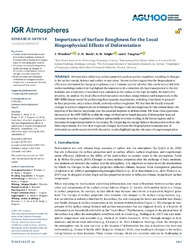Importance of Surface Roughness for the Local Biogeophysical Effects of Deforestation
DOI: https://doi.org/10.1029/2018JD030127
Persistent URL: http://resolver.sub.uni-goettingen.de/purl?gldocs-11858/8962
Persistent URL: http://resolver.sub.uni-goettingen.de/purl?gldocs-11858/8962
Winckler, J.; Reick, C. H.; Bright, R. M.; Pongratz, J., 2019: Importance of Surface Roughness for the Local Biogeophysical Effects of Deforestation. In: Journal of Geophysical Research: Atmospheres, Band 124, 15: 8605 - 8618, DOI: 10.1029/2018JD030127.
 |
Dokument öffnen: |
Deforestation influences surface properties such as surface roughness, resulting in changes in the surface energy balance and surface temperature. Recent studies suggest that the biogeophysical effects are dominated by changing roughness, and it remains unclear whether this can be reconciled with earlier modeling studies that highlighted the importance of a reduction of evapotranspiration in the low latitudes and a reduction of net shortwave radiation at the surface in the high latitudes. To clarify this situation, we analyze the local effects of deforestation on surface energy balance and temperature in the MPI-ESM climate model by performing three separate experiments: switching from forest to grass all surface properties, only surface albedo, and only surface roughness. We find that the locally induced changes in surface temperature are dominated by changes in surface roughness for the annual mean, the response of the diurnal amplitude, and the seasonal response to deforestation. For these three quantities, the results of the MPI-ESM lie within the range of observation-based data sets. Deforestation-induced decreases in surface roughness contribute substantially to winter cooling in the boreal regions and to decreases in evapotranspiration in the tropics. By comparing the energy balance decompositions from the three experiments, the view that roughness changes dominate the biogeophysical consequences of deforestation can be reconciled with the earlier studies highlighting the relevance of evapotranspiration.
Statistik:
ZugriffsstatistikSammlung:
Schlagworte:
deforestationland use change
biogeophysical effects
local effects
surface roughness
surface energy balance
This is an open access article under the terms of the Creative Commons Attribution-NonCommercial-NoDerivs License, which permits use and distribution in any medium, provided the original work is properly cited, the use is non-commercial and no modifications or adaptations are made.

